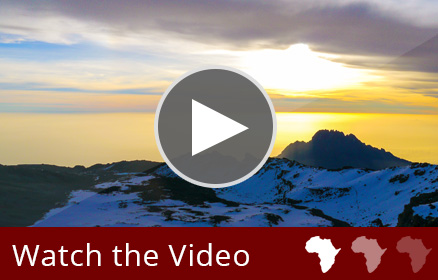MACHAME ROUTE WITH CRATER OVERNIGHT
8 day camping trekking tour + 2 nights hotel stay
The Machame Route is one of the most popular routes on the mountain and contends with the Lemosho route for the title of the most picturesque route. This new route allows you to add the unique experience of a night’s stay in the crater rim of Kilimanjaro before you summit.
Machame is steeper than Marangu or Rongai and physically more demanding, but it’s very good for acclimatization. It joins the Lemosho Route at New Shira Camp.
Highlights
Day 1
Start: Machame Gate (1790 m)
Finish: Machame Camp (3020 m)
Altitude: ↑ 1230 m
Walking Time: 5-6h
A long hike through the lush rainforest.
Day 2
Start: Machame Camp (3020 m)
Finish: New Shira Camp (3845 m)
Altitude: ↑ 825 m
Walking Time: 4-6h
Wonderful views of the Shira Ridge and the Kibo mountain range. The route is shorter than the previous day.
Day 3
Start: New Shira Camp (3845 m)
Finish: Barranco Camp (3960 m)
Altitude: ↑ 815 m ↓ 680 m
Walking Time: 6-7h
A longer stage with great views and fascinating landscapes, including the iconic Lava Tower
Day 4
Start: Barranco Camp (3960 m)
Finish: Karanga Camp (4035 m)
Altitude: ↑ 100 m ↓ 25 m
Walking Time: 3-4h
Conquering the Barranco Wall, breathtaking views of a glacier waits. More ups and downs.
Day 5
Start: Karanga Camp (4035 m)
Finish: Barafu Camp (4640 m)
Altitude: ↑ 605 m
Walking Time: 3-4h
Moderate ascent. Views of the southern glaciers. The altitude will become noticeable.
Day 6
Start: Barafu Camp (4640 m)
Finish: Crater Camp (5730 m)
Altitude: ↑ 1090 m
Walking Time: 6-7h
A long day of strenuous climbing to the highest camp on the mountain.
Day 7
Start: Crater Camp (5730 m)
Finish: Uhuru Peak (5895 m) – Mweka Camp (3080 m)
Altitude: ↑ 165 m ↓ 2815 m
Walking Time: 7-9h
A short but slow and difficult final stretch to the summit, then a much faster descent back into the rainforest.
Day 8
Start: Mweka Camp (3080 m)
Finish: Mweka Gate (1630 m)
Altitude: ↓ 1450 m
Walking Time: 2-3h
A traditional farewell ceremony followed by a swift and easy descent through the rainforest to the gate and your lift back to Moshi
Itinerary
Kilimanjaro Airport – Usa River
After your arrival at Kilimanjaro Airport, you will be greeted by our transfer driver and taken to the Meru View Lodge, your accommodation for tonight in Usa River. The rest of the day is free for you to do as you please; you can either relax at the hotel or explore the small town of Arusha, which is only a short taxi drive away. Later today you will get a comprehensive briefing on what to expect during your trek, and we will also check your equipment to make sure that you have everything you need.
Dinner
Day 1 Usa River – Machame Gate (1790 m) – Machame Camp (3020 m)
You will be picked up at your lodge in the morning after breakfast and head towards Machame Gate. At the gate you will be registered by the National Park authorities. Once everything is prepared you can start your trek into the lush rainforest. There is the possibility of spotting some Black-and-White Colobus monkeys on the way to Machame camp, which will take you about 5 to 6 hours to reach. You will spend the night just above the forest line at 3020 meters.
Breakfast; Lunch; Dinner
Day 2 Machame Camp (3020 m) – New Shira Camp (3845 m)
Today the trail will be a somewhat steeper than on day one but it’s is a shorter stretch and you should reach your destination by early afternoon. After some rest you have the option to hike further to Shira 2 Camp for beautiful views of the Shira Plateau. Mount Meru, the second highest mountain in Tanzania, can be seen in the distance. The night will be spent at New Shira Camp.
Breakfast; Lunch; Dinner
Day 3 New Shira Camp (3845 m) – Lava Tower (4640 m) – Barranco Camp (3960 m)
Today you will ascend about 700 meters to the striking and rugged Lava Tower before descending again to Barranco Camp. This will give your body a good chance to acclimatize for the following days as you will reach an altitude of over 4600 meters. The landscape will change dramatically over the course of today as you enter the afro-alpine desert close to Lava Tower and then descend back into the lush, green Barranco Valley. Barranco Camp is situated just below the imposing Barranco Wall and is reached after about 6 to 7 hours of trekking. This camp is considered by many to be the most beautiful and scenic on Kilimanjaro. You will be treated to a hearty dinner before getting into your sleeping bag for some well-deserved rest.
Breakfast; Lunch; Dinner
Day 4 Barranco Camp (3960 m) – Karanga Camp (4035 m)
Today you will tackle the steepest part of this route – the famous Barranco Wall, also known as the ‘Breakfast Wall’. It’s not as difficult as it looks, and your guide will assist you through this passage in just a little more than an hour. On top of Barranco Wall you can get a glimpse of the southern glaciers of Kibo and take a short rest before continuing towards Karanga Camp. This camp is located less than 100 meters higher then Barranco Camp which gives your body some more time to acclimatize to the altitude. After your lunch at the camp you have the option to do a short round trip towards Barafu Camp for further acclimatization, or you can just relax at your camp.
Breakfast; Lunch; Dinner
Day 5 Karanga Camp (4035 m) – Barafu Camp (4640 m)
The trail that you will take today passes back through striking alpine desert expanses and leads you to your final camp before the summit hike – the Barafu Camp. This camp will be reached after about 3 to 4 hours and sits at an altitude of 4640 meters. You will have some time to relax before the evening meal is served. After dinner you are advised to get as much sleep as possible before ta testing climb tomorrow.
Breakfast; Lunch; Dinner
Day 6 Barafu Camp (4640 m) – Crater Camp (5730 m)
In the early morning you will start the most challenging part of the ascent as the sun rises. You should reach Stella point, the crater rim of Kibo, after about 5-7 hours of strenuous climbing up the scree and ash paths. From Stella Point you will head towards the highest camp on Kilimanjaro – the Crater Camp – which is situated at an altitude of 5730 m. From here there are breath-taking views of the surrounding glaciers.
Breakfast; Lunch; Dinner
Day 7 Crater Camp (5730 m) – Uhuru Peak (5895 m) – Mweka Camp (3080 m)
The first sunlight marks the start of your final ascent towards the summit. It will be a slow and arduous 2 hours or so before you reach the highest point in Africa, Uhuru Peak, which towers above anywhere else in Africa at 5895 meters. From the peak, you will be able to see the surrounding summits, glaciers and landscapes being lit up by the warm morning sun – a truly unforgettable experience. After a short break and the mandatory summit pictures, you will return to Barafu Camp where the rest of the climbing crew will await you. Here you will have some time to rest and a much-needed warm meal will be served. Afterwards, you will continue your descent to Mweka Camp (3080 m) which will take you about 3 hours. At Mweka Camp you will have an evening meal followed by a well-deserved deep night’s sleep.
Breakfast; Lunch; Dinner
Day 8 Mweka Camp (3080 m) – Mweka Gate (1630 m) – Usa River
After breakfast you will be invited to take part in the traditional farewell ceremony with your mountain crew before the final leg of your climb leads you back through the lush rainforest. A gentle descent of up to 3 hours takes you to Mweka Gate where our driver will meet you and bring you back to the Meru View Lodge in Usa River. The rest of the day is yours. You may relax and stay at the pool, celebrate your accomplishment with a couple of drinks or just doze away contentedly.
Breakfast; Dinner
Usa River – Kilimanjaro Airport
After breakfast, you continue with your travel plans. You will be taken to Kilimanjaro Airport. Fly back home, continue to Zanzibar for a beach break or join a safari in Tanzania with Tanzania-Experience.
Breakfast
Price includes:
- Trekking tour according to the itinerary
- Accommodation in tents and hotels as indicated in the itinerary
- Professional English-speaking guide
- Personal porter
- Meals as indicated in the itinerary
- Drinking water
- Transfers as indicated in the itinerary
- Camping equipment – tents, sleeping mattress and camping furniture
- Portable toilet and toilet tent
- National park fees
- Rescue fees
Price excludes:
- Flights (international and domestic)
- Meals not indicated in the itinerary
- Beverages other than water (alcohol and soft drinks)
- Visa, tips, personal expenses, travel insurance
- Sleeping bag (can be rented, please ask us at the time of the booking)
FAQ
- The group size is between five and a maximum of ten persons
- On a private climb, you choose your hiking partners. You will not be teamed up with strangers. We can accommodate private groups of up to 100 or so.
As per the national park authorities, the minimum age for climbing Kilimanjaro is 10 years but seeing that children are more prone to altitude sickness than adults, we recommend a minimum age of 12. There is no maximum age restriction, but a medical check-up is advisable for people over the age of 60.
Kilimanjaro is one of the few mountains of its height that can be summited without mountaineering skills or experience. You should however be healthy and fit enough to manage the 4-6 hour hike each day, as well as the 12-14 hour hike on the day of the summit. For the last stretch, much endurance and willpower is needed.
Generally yes. We however discourage any attempts during the main rainy season (end of March to beginning of June). During the short rainy season (November), daily short rainfalls and cloudy views can be expected. From December until the end of February, temperatures are at their highest and rainfall is at its minimum. These are the busiest times. Between the end of June and the middle of October is also a good time to climb. Temperatures are a little lower but there is almost no rain.
The Lemosho route begins on the rather remote western side of Kilimanjaro, but meets up with the Machame route on day 3 at the Shira Plateau. The Lemosho route is the longest route and it covers the most kilometres, which is why one should allow a minimum of seven days for the climb.
Overnight accommodation will be in two-man tents and sleeping mats are provided. Single travellers usually share a tent with another group member of the same gender. Single tents can be provided on request at additional cost.
There are no ablution facilities except for basic long-drops (very simple latrines), but on private climbs mobile chemical toilets are included.
- Fresh water will be collected from the available sources on the mountain and is boiled before it’s served. Porters will carry water in canisters for the higher areas, where no more fresh water is available. All meals are freshly prepared by your cook.
- Meals are included as indicated in the itinerary.
- Breakfast usually consists of fruit, scrambled eggs, porridge, toast and jam, hot chocolate, coffee or tea. For lunch you are usually provided with a lunch box that contains sandwiches, boiled eggs, chicken etc.
- For dinner you will be served a soup and bread followed by the main course that either consists of red meat or poultry served with some sort of starch (chips, mashed potatoes, pasta or rice) and vegetables. For dessert you will get fresh fruit, hot chocolate, coffee or tea and milk.
- Breakfast and dinner are served in a mess tent that is equipped with a table and chairs while lunch is usually enjoyed en-route.
- We are able to provide meals for vegetarians or people with other dietary requirements or food allergies but we need to know in advance in order to cater for special requests.
Almost every hiker attempting Kilimanjaro will notice the altitude and the thinner air. Fitness fanatics are just as likely to suffer from it as couch potatoes. Symptoms include headaches that are often accompanied by fatigue, loss of appetite and nausea. More often than not, symptoms are mild, allowing you to continue to ascend. Occasionally the symptoms are more severe and a rapid descent is required, after which your body tends to recover quite quickly. Please however always keep in mind, that severe altitude sickness can be life-threatening and it may even lead to death. We do not recommend the use of medication, as it suppresses the symptoms of altitude sickness. We do however encourage you to drink enough water to replace the fluids lost from the physical activity. Two to four litres per day are recommended, as well as mineral supplements (magnesium etc.) to help replace lost minerals and to prevent muscle cramps.
- Unfortunately there are no state of the art mountain rescue services like the ones to be found in the European Alps for example. If you no longer have the ability to walk, you will either be carried or transported on a wheeled stretcher. This is by no means a pleasant experience which is why we encourage you not to overstrain your body and to travel safe. Helicopters can only land at a lower altitude and are therefore rarely used.
- Please ensure that you are covered by your health insurance while travelling. If you do not have sufficient coverage, we highly recommend taking out appropriate travel insurance. Your insurance should cover all your medical expenses including costs for rescue and repatriation.
- It is common practice to tip the members of your mountain crew after the climb. Tips make up a large portion of their income and are therefore highly appreciated. Below are some guidelines based on a group (not per person)
- Guide: 15-18 USD / day
- Assistant Guide: 12-15 USD / day
- Cook: 8-10 USD / day
- Waiter: 7-9 USD / day
- Porter: 6-7 USD / day
- Of course the above is just a guideline. If you are happy with the service received, you are welcome to show this when it comes to tipping.
- If you plan to tip in USD, please make sure the notes have been printed after 2004 as any earlier dated bank notes are not valid and can therefore not be used in Tanzania.
- Travel bag, backpack or kitbag, weighing no more than 12kg. Please do not bring a suitcase or trolley bag, as this type of luggage cannot be carried by the porters.
- Day backpack with rain protection.
- High quality sleeping bag for harsh conditions (at night temperatures can drop to -20°C).
- Different layers of clothing including thermal base layers, fleece clothing, trekking pants, warm jacket and water-resistant top layers as well as a warm headgear.
- Water-resistant and comfortable hiking boots and a variety of trekking socks.
- Please note that the above list is not complete and these are just a few things that you will have to bring with you. Once we have confirmed your booking, you will receive a more detailed list.
- Citizens of all nationalities need to contact the embassies of their travel destination to check the visa regulations.
- In general, European citizens can apply for a Tanzanian Tourism Visa upon arrival in Tanzania.
- It is the sole responsibility of every traveller to be in possession of the required documents and visa that allows them to enter their holiday destination.
- Tanzania is no longer a yellow fever region, so a yellow fever certificate isn’t generally a requirement. If visiting any other countries in the region either before or after Tanzania, be sure to check if a yellow fever vaccination is required
- Although there are no mosquitoes at high altitude, Tanzania is within a malaria region. It is up to you if you wish to take medication, but we suggest that you speak to your doctor or travel clinic about the different prophylaxis and their effects and side-effects.
- Although Tanzania does not require proof of immunization against tetanus, diphtheria, polio and hepatitis A and B, we nevertheless recommend those vaccinations.






























